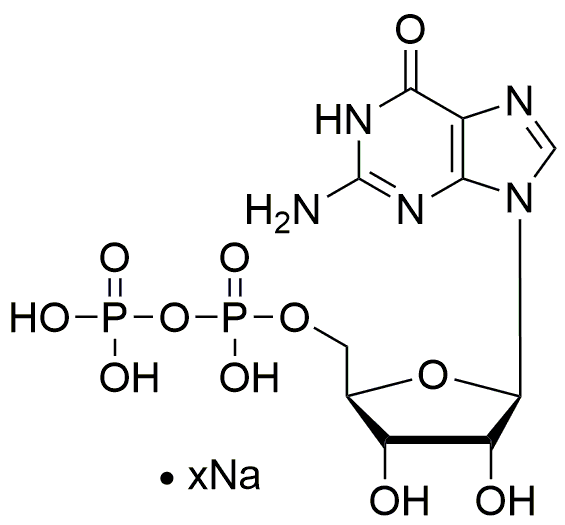Guanosine-5'-diphosphate sodium salt is widely utilized in research focused on:
- Biochemical Research: This compound serves as a crucial substrate in studies involving nucleotide signaling pathways, helping researchers understand cellular processes like energy transfer and signal transduction.
- Pharmaceutical Development: It plays a significant role in drug formulation, particularly in the development of therapeutics targeting G-protein coupled receptors, which are vital in various physiological responses.
- Cell Biology: Used in cell culture studies, it aids in investigating cell proliferation and differentiation, providing insights into cancer research and regenerative medicine.
- Enzyme Activity Assays: This sodium salt is essential in enzyme kinetics studies, allowing scientists to measure the activity of enzymes that utilize nucleotides, thus facilitating drug discovery and metabolic pathway analysis.
- Genetic Engineering: It is employed in molecular biology techniques, such as the synthesis of RNA and DNA, which are critical for genetic manipulation and synthetic biology applications.
Informations générales
Propriétés
Sécurité et réglementation
Applications
Guanosine-5'-diphosphate sodium salt is widely utilized in research focused on:
- Biochemical Research: This compound serves as a crucial substrate in studies involving nucleotide signaling pathways, helping researchers understand cellular processes like energy transfer and signal transduction.
- Pharmaceutical Development: It plays a significant role in drug formulation, particularly in the development of therapeutics targeting G-protein coupled receptors, which are vital in various physiological responses.
- Cell Biology: Used in cell culture studies, it aids in investigating cell proliferation and differentiation, providing insights into cancer research and regenerative medicine.
- Enzyme Activity Assays: This sodium salt is essential in enzyme kinetics studies, allowing scientists to measure the activity of enzymes that utilize nucleotides, thus facilitating drug discovery and metabolic pathway analysis.
- Genetic Engineering: It is employed in molecular biology techniques, such as the synthesis of RNA and DNA, which are critical for genetic manipulation and synthetic biology applications.
Documents
Fiches de données de sécurité (FDS)
La FDS fournit des informations de sécurité complètes sur la manipulation, le stockage et l’élimination du produit.
Spécifications du produit (PS)
Le PS fournit une description complète des propriétés du produit, notamment sa composition chimique, son état physique, sa pureté et les exigences de stockage. Il détaille également les plages de qualité acceptables et les applications prévues du produit.
Certificats d'analyse (COA)
Recherchez des certificats d'analyse (COA) en saisissant le numéro de lot du produit. Les numéros de lot et de lot se trouvent sur l'étiquette d'un produit, après les mots « Lot » ou « Lot de fabrication ».
Numéro de catalogue
Numéro de lot/série
Certificats d'origine (COO)
Ce certificat d'exploitation confirme le pays dans lequel le produit a été fabriqué, et détaille également les matériaux et composants utilisés et s'il est issu de sources naturelles, synthétiques ou autres sources spécifiques. Ce certificat peut être requis pour les douanes, le commerce et la conformité réglementaire.
Numéro de catalogue
Numéro de lot/série
Fiches de données de sécurité (FDS)
La FDS fournit des informations de sécurité complètes sur la manipulation, le stockage et l’élimination du produit.
DownloadSpécifications du produit (PS)
Le PS fournit une description complète des propriétés du produit, notamment sa composition chimique, son état physique, sa pureté et les exigences de stockage. Il détaille également les plages de qualité acceptables et les applications prévues du produit.
DownloadCertificats d'analyse (COA)
Recherchez des certificats d'analyse (COA) en saisissant le numéro de lot du produit. Les numéros de lot et de lot se trouvent sur l'étiquette d'un produit, après les mots « Lot » ou « Lot de fabrication ».
Numéro de catalogue
Numéro de lot/série
Certificats d'origine (COO)
Ce certificat d'exploitation confirme le pays dans lequel le produit a été fabriqué, et détaille également les matériaux et composants utilisés et s'il est issu de sources naturelles, synthétiques ou autres sources spécifiques. Ce certificat peut être requis pour les douanes, le commerce et la conformité réglementaire.


